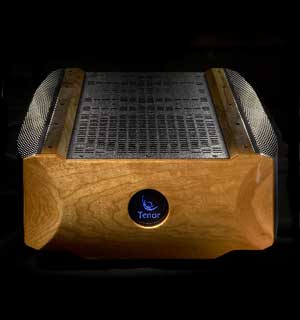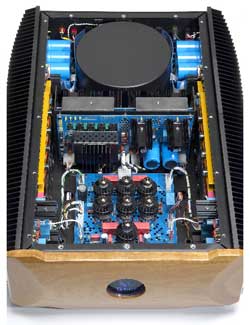Tenor Audio Makes a Comeback With Their New High-end,
Hybrid 350M Monoblock Amplifiers
by Ernie Fisher
 It was immediately after the Montreal Audio Show, back in
April of 2008, that my friend and ex partner Sol Scharf volunteered
to make use of his house as the auditioning studio for the
totally re-designed Tenor Audio amps. It was immediately after the Montreal Audio Show, back in
April of 2008, that my friend and ex partner Sol Scharf volunteered
to make use of his house as the auditioning studio for the
totally re-designed Tenor Audio amps.
Having auditioned them under uncontrolled conditions at
the show hinted at something very special. The first day
with Kharma speakers, the Tenors sounded sublime, while the
following day connected to Avalon speakers, I didn’t
hear peak performance. Sol and I proposed an audition, using
Sol’s source component, an Audio Aero Classic player
(same as mine) and his loudspeakers, a pair of WLM Grand
Violas, one of my all-time favourite pair of loudspeakers.
Everything had been connected to the $10K RCM Bonasus integrated
tube amp using Valhalla cables throughout. Enter the Tenors.
Appearance
Creating art is one thing, but designing a work of art
is a process of achieving the complex, abstract succession
of ideas and inspirations and connecting them to the arts.
And the Tenor’s designers didn’t disappoint
as they succeeded in creating the world’s best looking
amplifiers with an equally stunning preamp design matching
the amps’ appearance. The sculptured sigmoid front
panels are made of cherry wood, hand polished to perfection.
The centre window — a round back-lit design with the
company logo shows when the amp is in the standby mode, glowing
red, and in the operating mode when glowing blue — a
touch of class and ever-so enticing. The main AC switch is
located on each amp’s rear panel, while the standby
and mute switches are placed in front under the faceplate.
Also on the rear panel, two sets of speaker terminals, a
pair of RCA inputs and a pair of XLR inputs are logically
arranged.
Each monoblock measures 19.5 inches wide, 28 inches deep,
9.5 inches high and weighs 118 lbs (53.5 kg); the shipping
weight in the custom road case is 148 lbs (67.2 kg).
Sol and I both agreed that the amps are beautiful and we
hoped that their performance would match their appearance.
The Sound
After choosing some familiar recordings — an eclectic
mix ranging from Beethoven to Miles — we began with
our listening session. Beethoven’s Pastoral Symphony
was up first and it took less than 10 seconds for us to know
that we were listening to something exceptional, distinctive
and awe-inspiring. Sol and I looked at one another with astonishment,
as we didn’t expect an enormous improvement over Sol’s
system, which was selected for its great synergistic performance
and its musical potency. However, all-round musical improvements
were not only extensive, but also illuminating as the amps
clearly unfurled the most delicate harmonics of the music.
The first few minutes of listening had me scratching my
head with incredulity for all that had changed in the system
set-up was the replacement one amp with another. The only
additional component in the system was the prototype Tenor
preamplifier; (the finished version will be available in
a few months and will also feature an elaborate phono stage).
Sol’s reaction was the same as mine and we began to
discuss what we were hearing and how describe the sound;
the discussion lasted for several hours.
Next day, early in the morning, I took my compilation CD
and again fired up the Tenor system. In an effort to ascertain
the amp’s performance characteristics and how close
it is to the truth, the musical nucleus, I like to use musical
program material that challenges audio systems. To establish
the amplifiers’ ability to resolve bass fundamentals
and harmonics, I used my compilation CD that begins with
bass, three basses to be exact. This established the amplifiers
skill to handle everything bass. The next tracks feature
male vocals (a jazzy blues arrangement), Mancini’s
theme from The Pink Panther, bluesy female vocals, Hammond
B3s, of course, opera and classical music —altogether
about 65 minutes of music. Well, I listened to it all once,
then once again with Sol; then, with the help of Sol’s
Magnum MD108 tuner, we both listened to Montreal’s
CBC and jazz stations. Later that day, while Sol went about
his business, I listened to some more tunes and tried to
devise a formula that could define the sound of the amps.
Having done this many times in the past, it should have been
easy, but it wasn’t and after some serious thinking,
I came to the conclusion that, while it is extremely difficult
to properly describe sound, it is even more perplexing to
explicate sound one has never heard before.
 The Tenor amps are almost indefinable due to the fact that
they do not manipulate, modify, add or subtract from the
organic reality of music, its instruments and performers.
The amplifiers do not have better resolution than some other
high-end amps I have auditioned; nor do I hear better tonal
equilibrium or imaging; bass, midrange and treble areas of
the Tenor’s frequency reach are very refined, by any
standards, but are in line with other great amps I know.
The difference, however, is in the Tenors’ ability
to evaporate into thin air, leaving nothing behind but music.
It’s the kind of occurrence that lends credibility
to the often-used term “transparency” — the
see-through quality. And that’s precisely what you
get when listening to the Tenors, though you can see them,
they do not conceal or obscure the complexity of musical
composition and the harmonic patterns of its instruments.
All aforementioned sonic elements — resolution, balance,
imaging, bass and treble — are joined uncannily and
seem a little less confined than in any other amplifier I
have auditioned. Though I know of some amps that sound similar
(Wyetech Labs original Topaz and the new Ruby Series prototypes
I have in-house now), the Tenors still manage to heighten
the sonic refinement. Among the many delicate fine distinctions,
I noticed that every note in any frequency segment has its
own singular environment, but blends insidiously into euphonious
melody. The Tenor amps are almost indefinable due to the fact that
they do not manipulate, modify, add or subtract from the
organic reality of music, its instruments and performers.
The amplifiers do not have better resolution than some other
high-end amps I have auditioned; nor do I hear better tonal
equilibrium or imaging; bass, midrange and treble areas of
the Tenor’s frequency reach are very refined, by any
standards, but are in line with other great amps I know.
The difference, however, is in the Tenors’ ability
to evaporate into thin air, leaving nothing behind but music.
It’s the kind of occurrence that lends credibility
to the often-used term “transparency” — the
see-through quality. And that’s precisely what you
get when listening to the Tenors, though you can see them,
they do not conceal or obscure the complexity of musical
composition and the harmonic patterns of its instruments.
All aforementioned sonic elements — resolution, balance,
imaging, bass and treble — are joined uncannily and
seem a little less confined than in any other amplifier I
have auditioned. Though I know of some amps that sound similar
(Wyetech Labs original Topaz and the new Ruby Series prototypes
I have in-house now), the Tenors still manage to heighten
the sonic refinement. Among the many delicate fine distinctions,
I noticed that every note in any frequency segment has its
own singular environment, but blends insidiously into euphonious
melody.
Listening to the Tenor amps is experiencing the integral
energy of the music, which allows an unblemished view into
the sound-scape from a high observation point. For me, the
amplifiers evoke the impression that everything audio is
in good order.
Synopsis & Commentary
Well, I have no hesitation nominating the Tenor amplifiers
the best of which I know. They delivered the best sound
Sol and I have ever heard and taught a couple of well-seasoned
audiophiles and music lovers what audio can be when design
is approached like fine art.
I’m tempted to run a list of all the great amplifiers
I have auditioned over the 22 years of evaluating audio components,
if for no other reason than to show that they are around.
My first audition of a Tenor amp — a 15 w/ch design — was
about seven years ago. It counted among the top ranking designs;
but then again, most serious high-end amps I know of have
a number of sonic elements resembling those of the Tenors.
Nevertheless, I have yet to hear one that will outperform
the 350Ms’ all-round organic distinction. The Tenors’ musical
quality is off the chart, the build quality is in line with
German precision engineering with the attention to details
of Swiss watchmakers; and the amps’ exterior design
reminds me of the skills of Italian instrument makers. In
other words, there isn’t anything unrefined.
It is important to choose loudspeakers that allow the amps
to be heard without adding colouration. The Kharmas were
a great match, though, I preferred the WLM Grand Violas for
a more relaxed, more organic equivalent. However, I believe
that any well-designed loudspeaker will sound good driven
by the Tenor amplifiers. Needless to say, it is important
to use the best back-up system components and to exercise
suitable care when setting up. When all things are done correctly,
you’ll end up with something very special, your very
own audio art.
|
